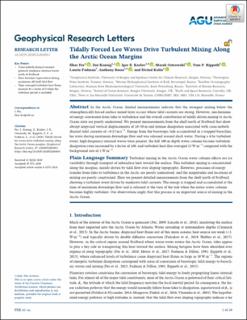| dc.contributor.author | Fer, Ilker | |
| dc.contributor.author | Koenig, Zoé Charlotte | |
| dc.contributor.author | Kozlov, Igor E. | |
| dc.contributor.author | Ostrowski, Marek | |
| dc.contributor.author | Rippeth, Tom | |
| dc.contributor.author | Padman, L. | |
| dc.contributor.author | Bosse, Anthony | |
| dc.contributor.author | Kolås, Eivind | |
| dc.date.accessioned | 2021-03-15T12:56:36Z | |
| dc.date.available | 2021-03-15T12:56:36Z | |
| dc.date.created | 2020-08-27T11:51:01Z | |
| dc.date.issued | 2020 | |
| dc.identifier.issn | 0094-8276 | |
| dc.identifier.uri | https://hdl.handle.net/11250/2733430 | |
| dc.description.abstract | In the Arctic Ocean, limited measurements indicate that the strongest mixing below the atmospherically forced surface mixed layer occurs where tidal currents are strong. However, mechanisms of energy conversion from tides to turbulence and the overall contribution of tidally driven mixing to Arctic Ocean state are poorly understood. We present measurements from the shelf north of Svalbard that show abrupt isopycnal vertical displacements of 10–50 m and intense dissipation associated with cross‐isobath diurnal tidal currents of ∼0.15 m s−1. Energy from the barotropic tide accumulated in a trapped baroclinic lee wave during maximum downslope flow and was released around slack water. During a 6‐hr turbulent event, high‐frequency internal waves were present, the full 300‐m depth water column became turbulent, dissipation rates increased by a factor of 100, and turbulent heat flux averaged 15 W m−2 compared with the background rate of 1 W m−2. | en_US |
| dc.language.iso | eng | en_US |
| dc.publisher | Wiley | en_US |
| dc.rights | Navngivelse 4.0 Internasjonal | * |
| dc.rights.uri | http://creativecommons.org/licenses/by/4.0/deed.no | * |
| dc.title | Tidally Forced Lee Waves Drive Turbulent Mixing Along the Arctic Ocean Margins | en_US |
| dc.type | Journal article | en_US |
| dc.type | Peer reviewed | en_US |
| dc.description.version | publishedVersion | en_US |
| dc.rights.holder | Copyright 2020. The Authors. | en_US |
| dc.source.articlenumber | ee2020GL088083 | en_US |
| cristin.ispublished | true | |
| cristin.fulltext | original | |
| cristin.qualitycode | 2 | |
| dc.identifier.doi | 10.1029/2020GL088083 | |
| dc.identifier.cristin | 1825493 | |
| dc.source.journal | Geophysical Research Letters | en_US |
| dc.source.40 | 47 | |
| dc.relation.project | Norges forskningsråd: 276730 | en_US |
| dc.subject.nsi | VDP::Oseanografi: 452 | en_US |
| dc.subject.nsi | VDP::Oceanography: 452 | en_US |
| dc.identifier.citation | Geophysical Research Letters. 2020, 47 (16), e2020GL088083. | en_US |
| dc.source.volume | 47 | en_US |
| dc.source.issue | 16 | en_US |

